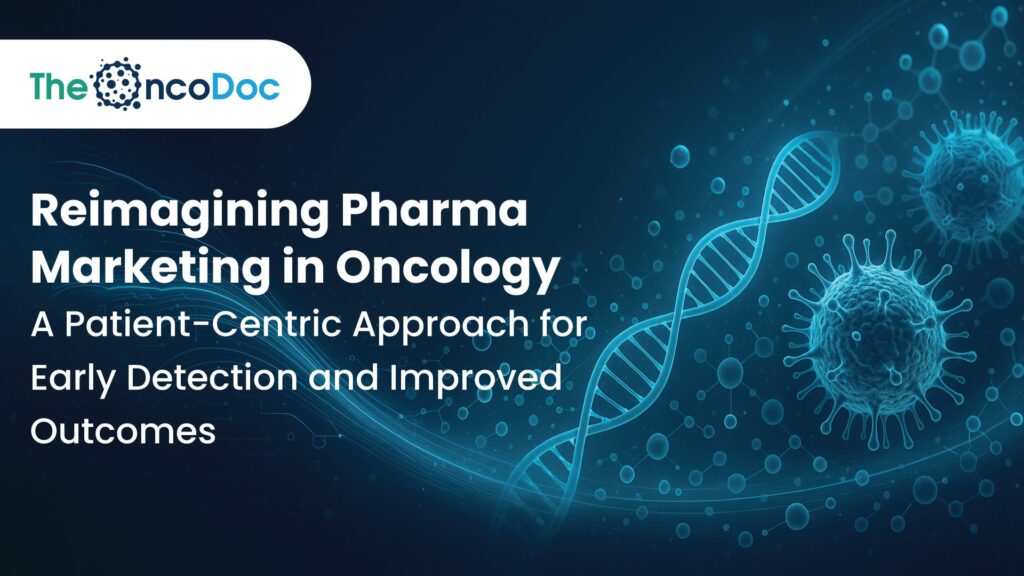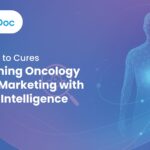Introduction: The Changing Mandate for Pharma Marketers
Pharmaceutical marketing, particularly in oncology, has traditionally revolved around promoting therapeutic innovations to oncologists and specialists. However, with rising cancer incidence globally and especially in low-to-middle-income countries like India, pharma companies are now recognizing the pivotal role they can play beyond treatment, specifically in early detection, timely referrals, patient education, and system-wide support.
In India, nearly 70–75% of cancer cases are detected at Stage III or IV, drastically reducing survival rates and increasing the treatment burden.
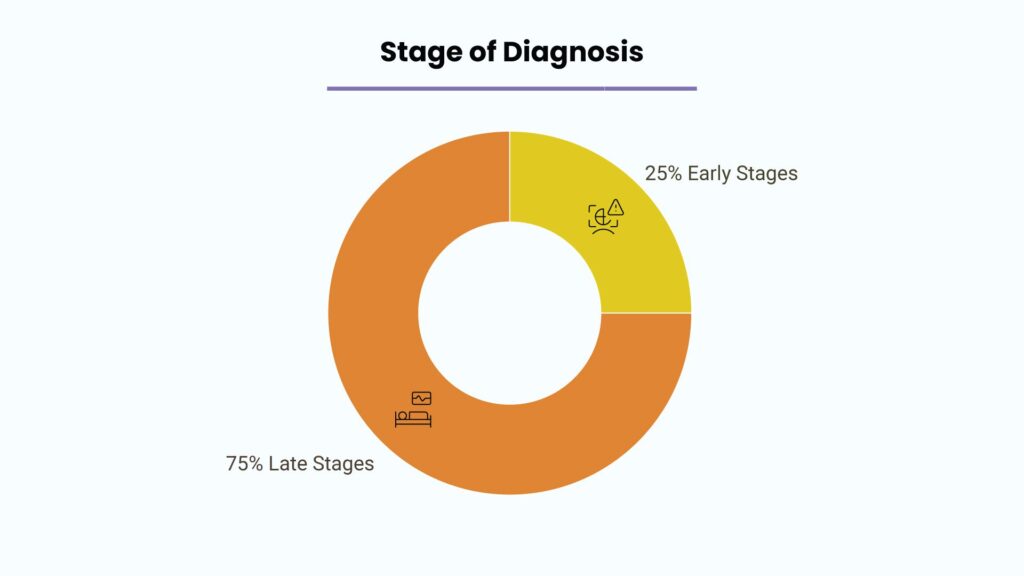
Amid these realities, the emerging mandate for pharma marketers is clear: move upstream in the care continuum. This involves targeting not just oncologists, but also general physicians, patients, caregivers, NGOs, and public health authorities.
Digital marketing, powered by AI, data analytics, and human-centric design, offers unprecedented tools for this transformation. The following article explores how pharma companies can unlock this potential through a strategic, integrated marketing approach centered on early detection in oncology.
Why Oncology Needs a Fresh Marketing Lens
Beyond Product Promotion: Toward Patient Ecosystem Enablement
The oncology space presents unique challenges and opportunities for marketers:
- Long diagnosis-to-treatment journey: Unlike acute diseases, oncology often involves a prolonged timeline from symptom onset to diagnosis.
- Multi-touchpoint decision-making: Patients interact with general practitioners, specialists, family, and digital sources before treatment begins.
- Emotionally charged environment: Cancer diagnoses come with fear, stigma, and information overload.
Thus, pharma marketing in oncology must not merely promote therapy, it must build trust, simplify navigation, and accelerate access to care.
Segmenting the Oncology Marketing Landscape
For maximum impact, pharma marketers must adopt a segmented approach, targeting different stakeholders with customized content and outreach strategies.
| Stakeholder | Needs | Suggested Approach |
| General Physicians (GPs) | Early symptom recognition, referral guidance | CME programs, symptom checklists, WhatsApp alerts |
| Oncologists | Patient education tools, early diagnosis partnerships | Digital toolkits, co-branded awareness materials |
| Patients & Caregivers | Symptom awareness, treatment navigation, emotional support | Multilingual campaigns, survivor videos, virtual counseling |
| NGOs & Public Health Bodies | Scalable interventions, outreach support | Co-hosted webinars, joint campaigns, analytics dashboards |
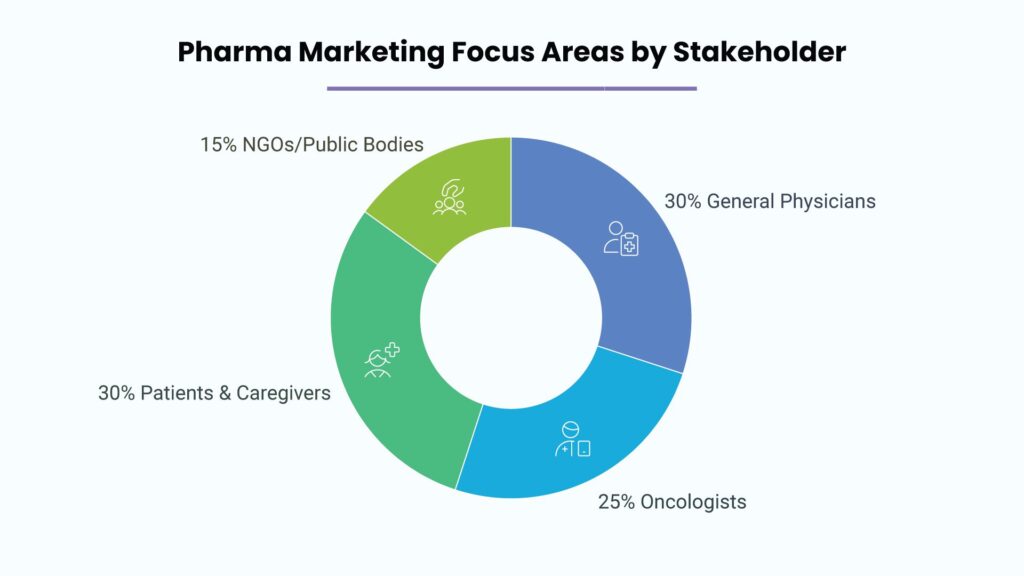
1. Empowering General Physicians with Digital Diagnostics
Many cancer journeys begin with a GP visit. Yet, studies reveal that many primary care providers miss early cancer symptoms due to low awareness, heavy workloads, and absence of decision support tools.
Marketing Tactics:
- Interactive CME modules: Featuring case simulations of early cancer signs.
- AI-powered WhatsApp bots: Offering instant symptom algorithms and referral pathways.
- Print + Digital Symptom Cards: Distributed via rep visits and downloadable links.
Engaging HCPs Through Gamified Microlearning
While awareness modules exist for HCPs, many go unused due to time constraints and fatigue. Gamification can enhance uptake and retention.
Formats That Work:
- “Spot the Symptom” Quizzes: Short, case-based gamified modules for mobile devices.
- Referral Races: Track and reward timely digital referrals for suspected cancer cases.
- Micro-certification Badges: CME credits awarded for completing oncology micro-courses, visible on LinkedIn or within professional communities.
Platforms like MedTrail, Practo Pro, and Hidoc Dr. are ideal for these efforts. Pharma brands should measure:
- Completion rates
- Repeat learners
- Average quiz accuracy
- Referral links clicked post-module
Engaging content and light competition can turn reluctant learners into proactive referrers.
2. Raising Public Awareness Through Precision Campaigning
One-size-fits-all awareness doesn’t work in India’s diverse landscape. Instead, pharma marketers can use hyper-targeted digital campaigns tailored to language, culture, and literacy levels.
Key Tactics:
- Google Search Ads: Triggered by symptom-based searches like “bloody cough” or “lump in neck”.
- Influencer-led Reels and Shorts: Using survivor stories in Hindi, Tamil, Bengali, etc.
- IVR Campaigns: Voice-based education through missed calls and automated callbacks.
3. Building Oncologist Collaboration Beyond the Hospital
Oncologists can act as advocates for early detection, but they need support.
Suggested Assets:
- QR-enabled wall posters: For outpatient clinics directing patients to education portals.
- Branded educational videos: Co-created with oncologists in regional languages.
- “Refer Early, Treat Early” Toolkits: For distribution via MRs and medical conferences.
By providing tools that oncologists can share with GPs or patients, pharma brands position themselves as partners in the fight against cancer, not just sellers of solutions.
Pharma-Supported Navigation Systems: Bridging Diagnosis to Treatment
After a diagnosis, patients face emotional, logistical, and financial barriers. Delays often occur not from a lack of medical services, but due to a lack of system navigation. Pharma companies can address this by supporting digital patient navigation services.
Core Features of Navigation Platforms:
- Treatment Timelines and Checklists: Custom paths depending on diagnosis, hospital, and insurance eligibility.
- Virtual Patient Coordinators: Available via chat to clarify appointments, explain lab reports, and guide next steps.
- City-wise Treatment Maps: Show top cancer care centers, their specialties, and contact details in regional languages.
Collaborations with cancer NGOs, telehealth providers, and survivorship groups can further boost credibility and effectiveness. This support also reinforces the pharma brand’s image as a health ally rather than just a product vendor.
4. Influencer & NGO Partnership: Trust Amplification Strategy
In regions where pharma brands lack deep community roots, trust becomes a barrier. Collaborating with NGOs, cancer survivors, and civil society groups can lend authenticity.
Examples:
- Webinar series with local cancer support groups
- Instagram takeovers by survivor-influencers
- Joint door-to-door symptom awareness drives in low-income districts
These campaigns should also loop in corporate CSR teams to co-fund and expand reach.
5. AI and Analytics: The Smart Marketer’s Superpowers
Modern digital campaigns succeed not just by reach, but by precision. AI tools help marketers:
- Identify HCPs with low referral activity
- Trigger automated nudges with personalized content
- Optimize campaign ROI in real time
Sample AI Use Cases:
- Chatbots for patient triage: “Do you have these symptoms? Here’s where to go.”
- Content sequencing engines: Show different messages based on user engagement.
- Geo-heatmaps: Track areas with rising symptom search volume.
6. Tier 2/3 India and WhatsApp: An Engagement Treasure Mine
WhatsApp is the most popular platform for patient and HCP outreach, with more than 500 million users. In Tier 2/3 cities, it’s the go-to source for information.
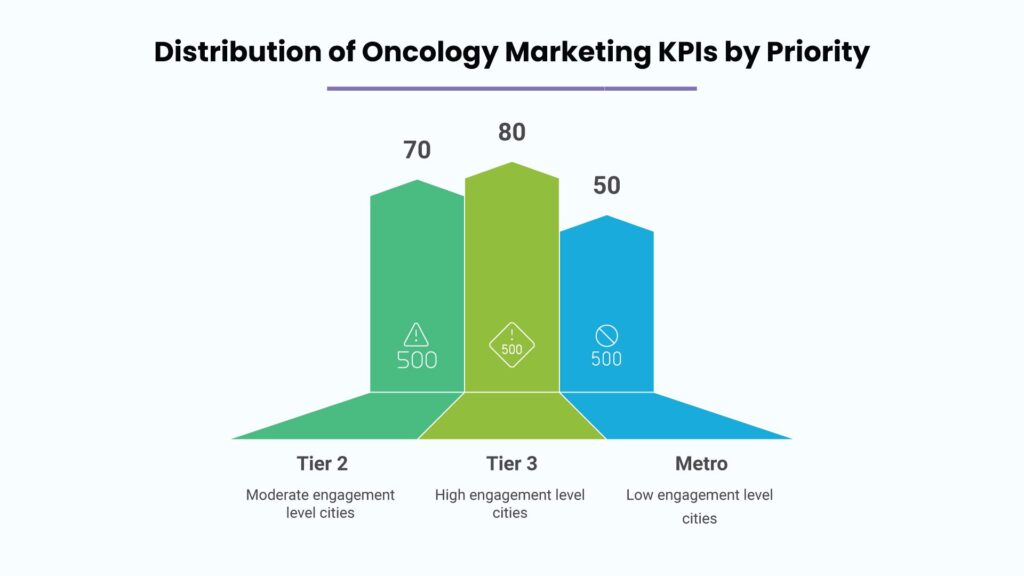
Examples of Campaigns:
- Weekly symptom tip videos for GPs
- Patient-forwardable PDFs on warning signs
- Click-to-chat buttons from ads for live consultations
Reaching the Rural Belt: Overcoming Last-Mile Barriers
Despite the boom in digital outreach, rural and tribal India often remains outside the influence of modern cancer awareness efforts. Limited internet access, low digital literacy, and deeply ingrained cultural beliefs mean that pharma marketers must combine offline and digital approaches for maximum reach.
Strategies for Last-Mile Penetration:
- Community Radio Messaging: Short symptom education audio clips broadcast on FM and local stations in regional dialects.
- Flashcard Toolkits for ASHAs and ANMs: Visually engaging tools that field workers can use to explain symptoms and screening procedures.
- Mobile Van Clinics: Sponsored by pharma brands in collaboration with local health departments, these vans can carry both diagnostics and awareness materials.
- Voicebot Campaigns: For populations with low literacy, automated voice messages in local languages explaining early signs of cancers like breast, cervical, and oral.
Rural outreach should also consider seasonality (harvest time, festivals) and gender sensitivities to ensure appropriate messaging windows and formats.
7. Making Oncology Campaigns Vernacular-First
In a linguistically rich nation, English-only campaigns miss the mark. Translating not just the words but the cultural relevance is key.
Strategies:
- Use of regional idioms in video content
- Voice-based explainer tools for illiterate or elderly audiences
- Local festivals and community health fairs as campaign anchors
Empowering Caregivers: The Silent Champions in Cancer Care
While the patient is at the center of the cancer care journey, caregivers,often family members,play a pivotal role in facilitating appointments, understanding treatment options, managing side effects, and providing emotional support. Yet, most oncology marketing neglects this vital group.
Why Caregiver Engagement Matters:
- High Influence on Decisions: Especially in India, where family consensus often shapes health decisions.
· Principal Communication and Logistics Source: Coordinating transportation and deciphering discharge summaries.
- Emotional Load: Caregivers themselves need psychological support and accurate information.
Pharma Marketing Strategies for Caregivers:
- Multilingual “Caregiver Kits”
Printable and digital resources covering:- Common side effects and home remedies
- Emergency red flag signs
- Financial aid and NGO helpline directories
These should be distributed via oncologists, WhatsApp channels, or hospital partnerships.
- Caregiver-Specific Web Portals
A separate section on patient support websites for caregivers, including:- Live Q&A with counselors
- Survivor spouse stories
- Time-management tips for working caregivers
- Emotional Health Tools
Guided meditation tracks, stress journal templates, and referral links to counseling,positioned as value-adds by the pharma brand, not therapy replacements. - Co-branded Support Groups
Partner with hospitals or NGOs to create hybrid caregiver groups (online + physical), moderated by professionals, sponsored subtly by pharma.
Real-World Example:
A recent campaign in Tamil Nadu launched by a pharma brand featured weekly Facebook Live sessions for caregivers. Topics ranged from “How to talk to your child about cancer” to “Managing medication side effects at home.” In just 8 weeks, caregiver engagement outpaced patient engagement by 2.3x.
By investing in the caregiver ecosystem, pharma marketers can indirectly improve patient adherence, satisfaction, and brand affinity,while demonstrating authentic empathy.
8. Integrating Policy and Public Health Collaboration
Public health initiatives like Ayushman Bharat and state-run screening programs can supercharge pharma’s reach if integrated wisely.
Tactical Collaborations:
- Co-branded screening dashboards: Real-time analytics for state oncology programs
- Training modules for ASHAs and ANMs: Leveraging pharma’s digital platforms
- Integration into government health apps: With referrals to brand-sponsored diagnostic centers
Engaging Insurers: Driving Preventive Incentives
India’s growing health insurance ecosystem is beginning to explore preventive care and early diagnosis as cost-control levers. Pharma companies and insurers can collaborate to develop ads that encourage early screenings.
Possible Initiatives:
- Free Screening Vouchers: For insured individuals in specific age-risk cohorts.
- Loyalty Points: Awarded for completing cancer symptom questionnaires or diagnostic tests.
- Data Exchange Agreements: To identify claims that suggest undiagnosed cancers (e.g., repeat painkiller prescriptions, weight loss claims).
Private insurers and Ayushman Bharat panels are seeking ways to reduce long-term payouts. Pharma marketers can position early detection support as a win-win for patients and payers.
9. Case Study: Cervical Cancer Digital Campaign in Uttar Pradesh
Goal: Increase Pap smear screening among women aged 30–50 in semi-urban areas
Strategy:
- Created regional-language Reels with female doctors busting myths.
- Ran WhatsApp chatbot for symptom screening + appointment booking.
- Partnered with a local NGO for on-ground camps.
Results in 3 months:
- 4.1 million impressions across Meta platforms
- 27,000 women screened
- 3x increase in clinic visits in target zones
10. Metrics That Matter: Tracking What Moves the Needle
Beyond vanity metrics (likes, views), pharma marketers must track outcomes such as:
- Referral form downloads
- Increase in early-stage diagnoses
- Symptom video completion rates
- HCP engagement with CME tools
Bridging Campaigns with Telehealth Ecosystems
With over 200 million Indians now having access to teleconsultation platforms post-pandemic, oncology campaigns need to integrate seamlessly into the telemedicine journey.
Why It Matters:
- Many patients never reach a physical hospital until Stage III.
- Teleconsultations are often the first point of healthcare access in rural and semi-urban areas.
- Cancer symptoms are often misattributed to lifestyle issues during short video consultations.
Marketing Opportunities for Pharma:
- Plug-in symptom screeners on platforms like Practo, Tata Health, or Mfine.
- On-demand micro-content for tele-doctors: Share-ready symptom flowcharts and red flag references.
- Sponsored screening reminders after certain teleconsultation tags (e.g., persistent cough, weight loss).
By embedding content and diagnostics directly into teleconsultation journeys, pharma marketers can activate early referrals without physically being present in the care setting.
11. Ethical Marketing in Oncology: Walking the Talk
Pharma companies must balance marketing with medical ethics, especially in cancer. Campaigns should avoid:
- Over-promising outcomes
- Exploiting patient fears
- Masking commercial intent in survivor stories
Instead, marketers must focus on truthful storytelling, patient empowerment, and doctor partnership.
Storytelling with Empathy: The Heart of Oncology Campaigns
Facts inform, but stories inspire. In oncology marketing, emotive storytelling humanizes information, breaks down stigma, and forges strong emotional connections between companies and stakeholders.
Why Narrative Design Works:
- Patients relate better to real-life journeys than to clinical data.
- Stories appeal to both emotions and memory, driving recall and action.
- Oncologists and HCPs value testimonials that reflect clinical impact and patient voice.
Tactics for Pharma:
- Docu-series of early diagnosis journeys: co-produced with patient advocacy groups.
- Regional testimonial campaigns: videos of survivors, caregivers, and doctors.
- Long-form blog articles or podcasts: hosted on health portals and local news platforms.
For example, a survivor-led campaign on oral cancer in West Bengal combined personal video diaries with QR codes linking to free screening centers. The campaign led to a 30% increase in footfall at local diagnostic clinics in under 2 months.
Pharma brands must prioritize consent, transparency, and dignity in such narratives. A well-told story can build trust where ads cannot.
12. Future Outlook: The Rise of Predictive Oncology Marketing
Looking ahead, predictive analytics and wearable integration could define the next frontier. Pharma marketers may be able to:
- Detect early symptom clusters via wearable data
- Personalise awareness content by behavior (e.g., smoking habits)
- Auto-trigger symptom questionnaires through fitness apps
Conclusion: From Marketers to Mission-Drivers
In the fight against cancer, pharma companies are not just stakeholders, they are potential system changers. Through thoughtful, evidence-based, and empathetic digital marketing, they can:
- Reduce diagnostic delays
- Empower the entire HCP chain
- Earn trust across the healthcare ecosystem
- Build sustainable brand equity with purpose
It’s time to look beyond product promotion. Early detection is not just a clinical goal, it’s a marketing imperative.
The Oncodoc team is a group of passionate healthcare and marketing professionals dedicated to delivering accurate, engaging, and impactful content. With expertise across medical research, digital strategy, and clinical communication, the team focuses on empowering healthcare professionals and patients alike. Through evidence-based insights and innovative storytelling, Hidoc aims to bridge the gap between medicine and digital engagement, promoting wellness and informed decision-making.

